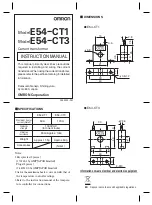
29
10.4.10 Alarm delay: dELA
This function enables activation of the alarm output to
be delayed for a fixed time following the alarm
condition occurring. The delay can be set in 1
second increments up to 3600 seconds. If a delay is
not required zero should be entered. To adjust the
delay select 'dELA' using the
▼
or
▲
button from the
alarm menu and press
P
which will reveal the existing
delay with one digit flashing. The flashing digit can
be adjusted using the
▼
or
▲
push button, and the
P
button to move control to the next digit. When the
required delay has been entered, press
E
to enter the
new setting and return to the ‘dELA’ prompt in the
alarm menu.
When an alarm occurs, the alarm annunciator will
flash until the delay time expires, when the alarm will
be activated and the annunciator will stop flashing.
10.4.11 Alarm silence time: SiL
This function is primarily intended for use in small
installations where the alarm output directly operates
a warning sounder or beacon. When the alarm
silence time is set to any figure other than zero, the
P
push button becomes an alarm accept button. After
an alarm has occurred, operating the
P
button will
cause the alarm output to revert to the non-alarm
condition for the programmed alarm silence time.
Ideally the BA474D requires an optional external
keypad for this function to be used.
To adjust the alarm silence time, which may be
between 0 and 3600 seconds, select 'SiL' from the
alarm menu using the
▼
or
▲
push button and press
P
to reveal the existing silence time with one digit
flashing. The flashing digit can be adjusted using the
▼
or
▲
push button and the
P
button to move control
to the next digit. When the required time has been
entered press
E
to return to the ‘SiL prompt in the
alarm menu.
When an alarm is cleared using the
P
push button,
the alarm annunciator will flash until the silence time
expires, if the alarm condition still exists the alarm will
be reactivated.
10.4.12 Access Setpoint: ACSP
This function controls a separate menu that provides
direct access to the alarm setpoints when the
BA474D transmitter is in the operational mode. The
function enables an operator to adjust the alarm
setpoints without having access to the configuration
and alarm menus. Further protection is provided by a
separate security code. Both setpoints can always
be displayed, but not adjusted, from the operating
mode using the
E
plus the
▼
or
▲
button – see
section 3.1
This direct access menu is enabled and a separate
security code entered from the 'ACSP' function in the
configuration menu as shown in Fig 14. To check or
change the menu parameters select 'ACSP' from the
menu using the
▼
or
▲
button and press
P
which will
display the enable prompt 'EnbL'. Press
P
again to
reveal the current setting which may be changed
using the
▼
or
▲
button.
If 'oFF' is selected, the operator will not have access
to the setpoints from the display mode. If 'on' is
selected, the operator will have direct access to the
alarm setpoints from the operational mode via a
separate optional security code. Press
E
to enter
the selection and return to the ‘EnbL’ prompt,
pressing
E
again will return the ‘ACSP’ prompt in the
configuration menu.
If the ‘ACSP’ function is enabled, access to the
setpoints from the transmitter operational mode may
be protected by an optional four digit code. This
access code is defined by sub-function ‘ACCd’ which
is reached from the 'EnbL' prompt by pressing the
▼
or
▲
button. Pressing
P
will then reveal the current
security code with one digit flashing. The flashing
digit may be changed by operating the
▼
or
▲
push
button and the
P
button to move control to the next
digit. When the required code has been entered,
press
E
twice to return to the 'ACSP' prompt in the
configuration menu.
Code 0000 disables this security code allowing, when
enabled, direct access to the setpoints from the
display mode by pressing the
P
and
▲
buttons
simultaneously.
New instruments with alarms are supplied with this
function disabled and the security code set to 0000













































